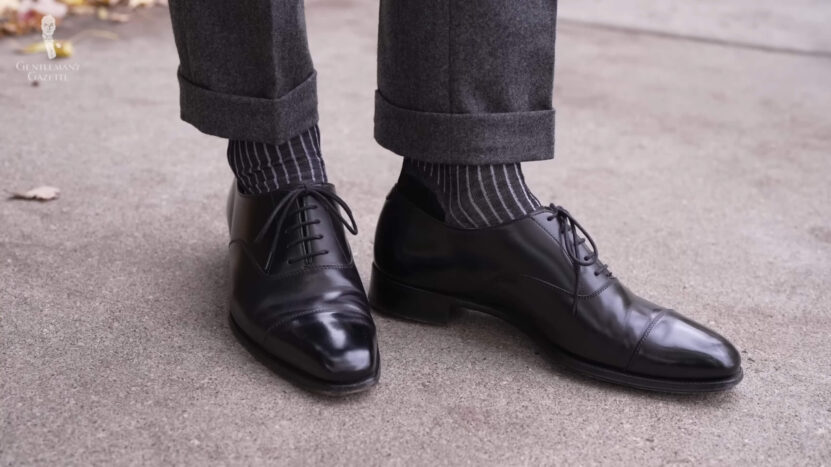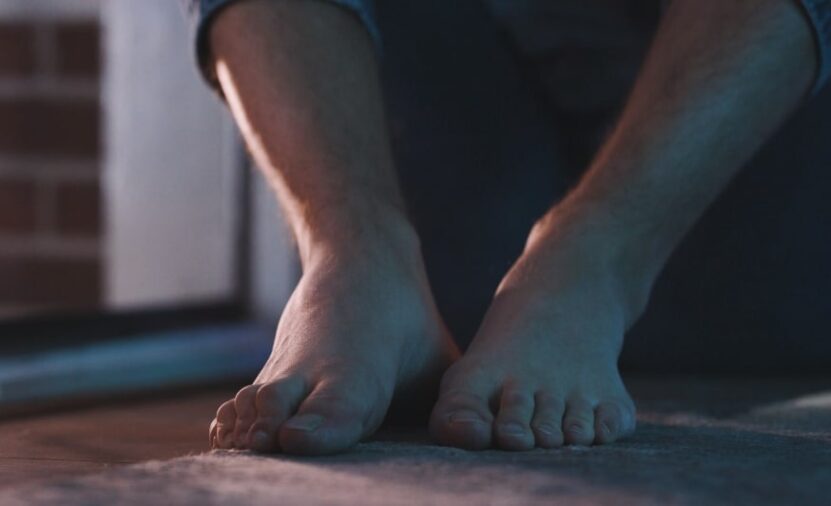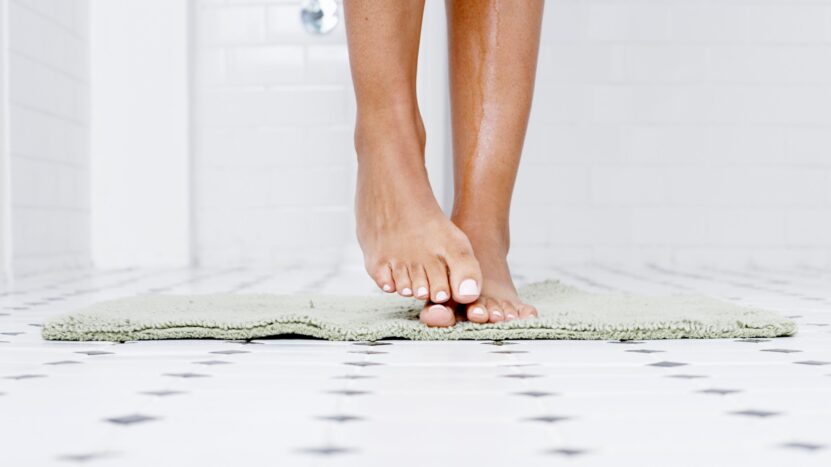Footwear is an essential part of our daily attire, but it can sometimes leave unwelcome marks on our feet.
Dark marks on feet from footwear are not just a cosmetic concern but can also indicate skin irritation or damage.
Today, I will help you find effective methods to remove these marks, ensuring your feet look and feel their best.
Key takeaways:
- Know the Causes: Knowing why dark marks appear is the first step in effective treatment.
- Prevention is Key: Proper footwear and foot care are essential in preventing dark marks.
- Choose the Right Treatment: Whether it’s home remedies, OTC products, or professional help, select what works best for your skin type.
- Consistency Matters: Regular care and preventive measures are crucial for lasting results.
- Seek Professional Help When Needed: If home and OTC treatments don’t work, consult a dermatologist.
The Causes
1. Friction and Pressure

Dark marks often result from prolonged friction and pressure. Tight or ill-fitting shoes can rub against the skin, leading to discoloration.
2. Material and Dye

The material and dye used in shoes can also contribute to these marks. Synthetic materials and dark dyes can irritate the skin or transfer color.
3. Moisture and Heat

Excessive sweating and heat can exacerbate skin irritation, leading to darkened areas, especially around straps and seams.
Prevention Strategies
- Proper Footwear Selection: Choosing the right footwear is crucial. Opt for shoes that fit well, offer good support, and are made from breathable materials.
- Use of Barriers: Consider using socks or protective insoles to minimize direct contact between your feet and the shoes.
- Regular Foot Care: Maintain good foot hygiene and use moisturizers to keep your skin supple and less prone to friction damage.
Home Remedies
Lemon Juice and Honey

Lemon juice is known for its natural bleaching properties, and honey for its moisturizing benefits. A mixture of these can lighten dark marks.
Aloe Vera

Aloe vera is excellent for soothing and healing skin. Apply it to the affected areas to reduce pigmentation and irritation.
Cucumber

Cucumber slices or juice can be applied to the feet. Its cooling effect helps reduce pigmentation and soothe the skin.
Over-the-Counter Solutions
Exfoliating Scrubs
Regular exfoliation can remove dead skin cells and lighten dark marks. Use a gentle scrub formulated for feet.
Skin Lightening Creams
Creams containing ingredients like kojic acid or vitamin C can help reduce pigmentation. However, use them cautiously and follow the instructions.
Medicated Foot Creams
For persistent marks, medicated creams with ingredients like hydroquinone may be recommended. Consult a dermatologist before use.
Professional Treatments
- Microdermabrasion: This procedure involves exfoliating the skin’s surface to reduce dark marks and improve overall skin texture.
- Chemical Peels: Chemical peels can help in reducing pigmentation by removing the top layer of skin. This should be done under professional guidance.
- Laser Therapy: For severe cases, laser therapy can be effective in reducing pigmentation. It’s a more invasive option and should be considered as a last resort.
Aftercare and Maintenance
Moisturizing and Protection
After treating dark marks, continue to moisturize your feet and protect them from excessive sun exposure to prevent recurrence.
Regular Monitoring
Keep an eye on your feet for any signs of new marks or irritation, and adjust your footwear and care routine accordingly.
Lifestyle Adjustments
Consider lifestyle changes like reducing time spent in tight footwear and choosing open-toed shoes when possible.
Tips for Healthy Feet
Maintaining healthy feet is not just about addressing issues like dark marks; it involves overall care. Here are some tips to keep your feet healthy:
- Regular Cleaning and Drying: Clean your feet daily and dry them thoroughly to prevent fungal infections.
- Footwear Rotation: Rotate your shoes regularly to give them time to air out and to reduce the risk of skin irritation from constant wear.
- Pedicures and Foot Massages: Regular pedicures and foot massages can improve circulation and keep your feet in good condition.
- Adequate Hydration: Drinking plenty of water helps maintain skin elasticity, reducing the likelihood of skin damage and pigmentation.
The Bigger Picture
While focusing on removing dark marks, it’s crucial to understand that foot health is a part of your overall well-being.
Factors like diet, hydration, and overall skin care play a significant role.
A balanced diet rich in vitamins and minerals supports skin health, helping prevent and heal skin issues more effectively.
Know About Different Skin Types
Different skin types react differently to treatments. It’s important to recognize your skin type and choose appropriate remedies.
Sensitive Skin
If you have sensitive skin, opt for milder, natural remedies and avoid harsh chemicals.
Dry Skin
Dry skin requires extra moisturizing. Choose treatments that hydrate while treating dark marks.
Oily Skin
For oily skin, light, non-greasy treatments are preferable to prevent clogging pores.
When to See a Dermatologist
If you’ve tried multiple remedies without success or if the dark marks worsen, it’s time to consult a dermatologist. They can provide:
- Professional Diagnosis: A dermatologist can accurately diagnose the cause of dark marks and suggest the best course of action.
- Advanced Treatments: They might recommend treatments like prescription creams, peels, or lasers, which are more effective for stubborn cases.
- Personalized Skin Care Routine: A dermatologist can also help you develop a personalized skincare routine suitable for your skin type and concerns.
FAQs
How Long Does It Take to Remove Dark Marks?
The time it takes to remove dark marks varies depending on the severity and the treatment method.
Home remedies might show results in a few weeks, while professional treatments could offer quicker results.
Are Home Remedies Safe for All Skin Types?
Most home remedies are safe for different skin types, but it’s important to do a patch test first.
If you have sensitive skin, consult a dermatologist before trying new treatments.
Can Dark Marks Reappear After Treatment?
Yes, dark marks can reappear, especially if the underlying causes, like wearing tight footwear, are not addressed.
Consistent foot care and preventive measures are essential.
Are There Any Side Effects of Over-the-Counter Lightening Creams?
Some skin lightening creams can cause side effects like skin irritation or allergic reactions.
It’s important to follow the instructions and not overuse these products.
Can wearing open-toed shoes help prevent dark marks?
Yes, wearing open-toed shoes can help by reducing friction and direct pressure on the skin, which are common causes of dark marks.
Is it advisable to wear socks with sandals to prevent marks?
Wearing socks with sandals can reduce skin contact with the material of the sandals, potentially preventing marks, but it might not be fashionably accepted.
However, that might not be the case with rainbow sandals, as wearing socks with them can be quite uncomfortable.
Can poor blood circulation contribute to dark marks on feet?
Yes, poor blood circulation can lead to skin changes, including discoloration or dark marks, especially around the ankles and lower feet.
Are dark marks from footwear a sign of a serious health issue?
Usually, they are not serious and are more of a cosmetic concern.
However, persistent or worsening marks should be checked by a healthcare professional to rule out other conditions.
Can changes in body weight affect the development of dark marks from footwear?
Yes, significant changes in body weight can alter the pressure and friction points on your feet, potentially leading to the formation of dark marks.
Is it possible for children to get dark marks from their footwear?
Yes, children can also get dark marks from tight or ill-fitting footwear, similar to adults. It’s important to ensure proper fit and comfort in their shoes.
Final Words
Dark marks on feet from footwear can be both a cosmetic and health concern. Knowing the causes and implementing prevention strategies are key.
Various home remedies, over-the-counter products, and professional treatments are available to address these marks effectively.
With the right care and attention, you can keep your feet looking healthy and mark-free. Keep in mind that foot health is an essential part of overall well-being.
Taking the time to care for your feet not only ensures they look good but also supports your comfort and mobility.
If you experience persistent problems or severe skin reactions, seeking professional medical advice is always advisable.

